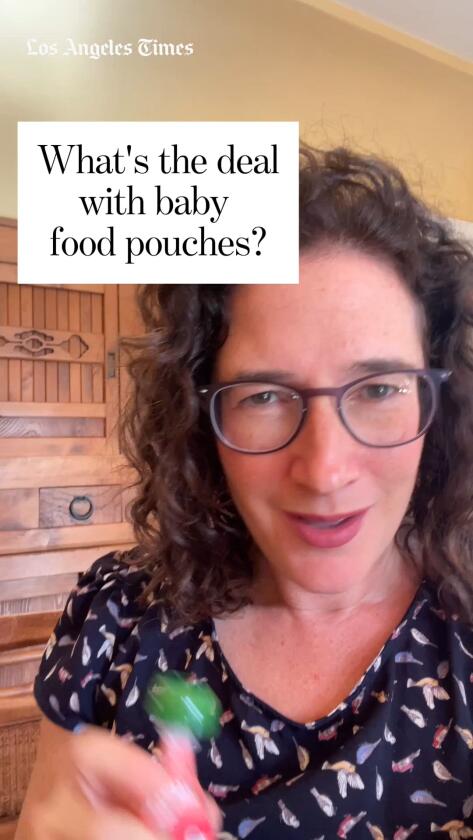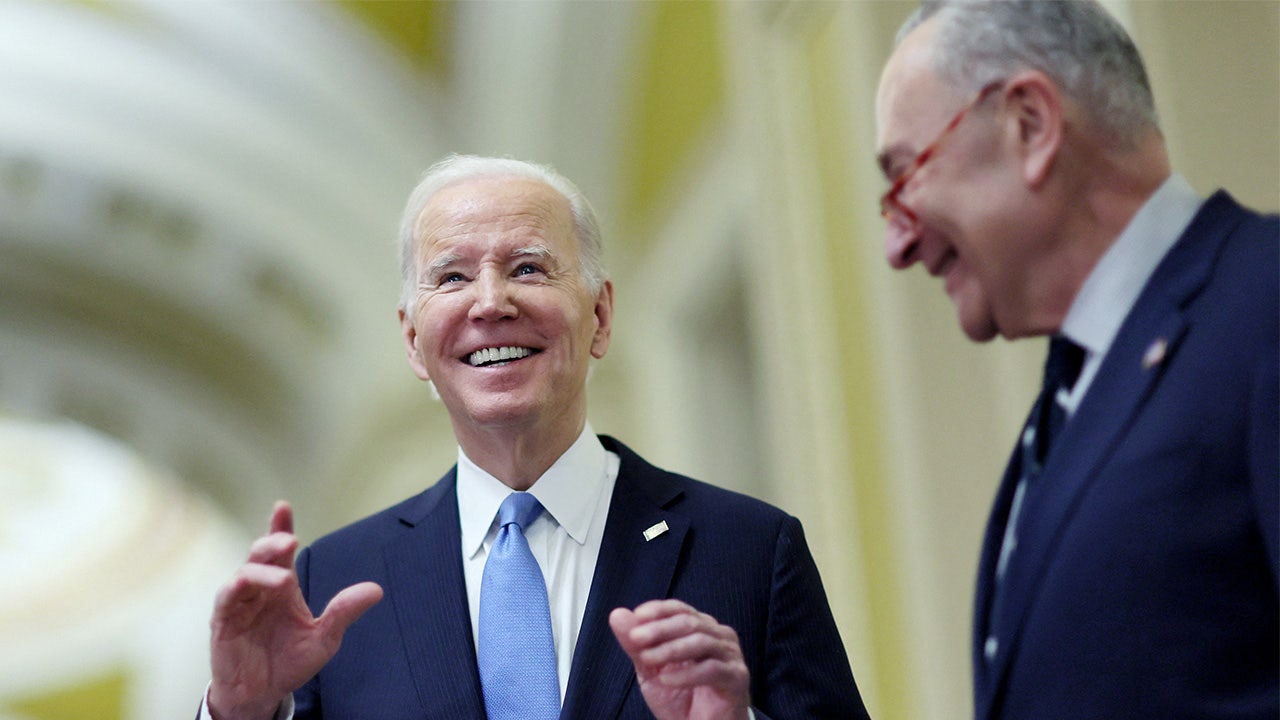Science
Kids are sucking down baby food pouches at record rates. ‘We’re going to pay for it,’ experts say

Every week, Caitlin Scuttio stops by Target and piles her cart with pureed food pouches for her 4-year-old and twin 18-month-olds sons.
In goes a 24-pack of unsweetened applesauce. Then a 24-pack of the fruit and veggie blend. And finally, the yogurt pouches for her oldest son’s breakfast. “He’d eat six apple sauce pouches a day if I let him,” Scuttio said.
Total monthly pouch budget: $200.
“They have such a choke hold on my family. I can’t imagine our grocery list without it at this point,” she said. “We are definitely a pouch family.”
Sales of baby food pouches have increased 900% over the last decade. Pouches are now the most popular baby food on the market.
And they aren’t alone. Sales of food pouches — soft bags with plastic spouts for easy consumption — have increased 900% since 2010, overtaking jarred purees as the predominant baby food on the market. Parents generally spoon-feed jars of pureed foods for a few months in the first year of life when introducing solids, but pouches marketed to parents of toddlers and older children have prolonged pureed food eating by years.
While the occasional pouch can be part of a healthy diet, doctors and nutritionists are raising concerns that an overreliance on pouches can interfere with nutrition, long-term food preferences, dental hygiene and even speech and language development. And marketing practices can leave parents confused about what’s actually inside the packages.
“Pouches are highly processed foods,” said Dr. Steven Abrams, a professor of pediatrics at the University of Texas at Austin Dell Medical School. “They certainly serve as a quick snack, but we need to make sure that pouches don’t make up too much of a toddler’s diet. We want kids to learn to chew and eat foods like meat, and fruits and vegetables that are not processed.”

Heidi Martinez gathers baby food pouches for her three kids at their home in Pittsburg, Calif. She said she always buys the pouches with at least one vegetable.
What’s inside varies greatly — some contain only fruit, while others have a mix of vegetables, grains, yogurt and even meat. Whereas many jarred foods contain a single ingredient like pureed peas or carrots, pouches are more often a blend that features a sweet fruit such as apple or pear as the primary ingredient.
A 2019 study found that infant and toddler food in pouches contained significantly more sugar per serving than foods available in other forms of packaging.
To be sure, there is not an epidemic of children who don’t know how to chew. But Dr. Mark Corkins, a pediatric gastroenterologist at the University of Tennessee Health Science Center who chairs the American Academy of Pediatrics committee on nutrition, said he sometimes sees children who are so reliant on the smooth, sweet taste of pouches that they have developed food and texture aversions and refuse to eat regular fruits or vegetables.
“In the long run we’re going to pay for it,” he said.
Engage with our community-funded journalism as we delve into child care, transitional kindergarten, health and other issues affecting children from birth through age 5.
Why are baby food pouches so popular?
Pouches are convenient: Unlike glass jars, they don’t shatter when dropped and toddlers can suck down the slurry without help from a caregiver.
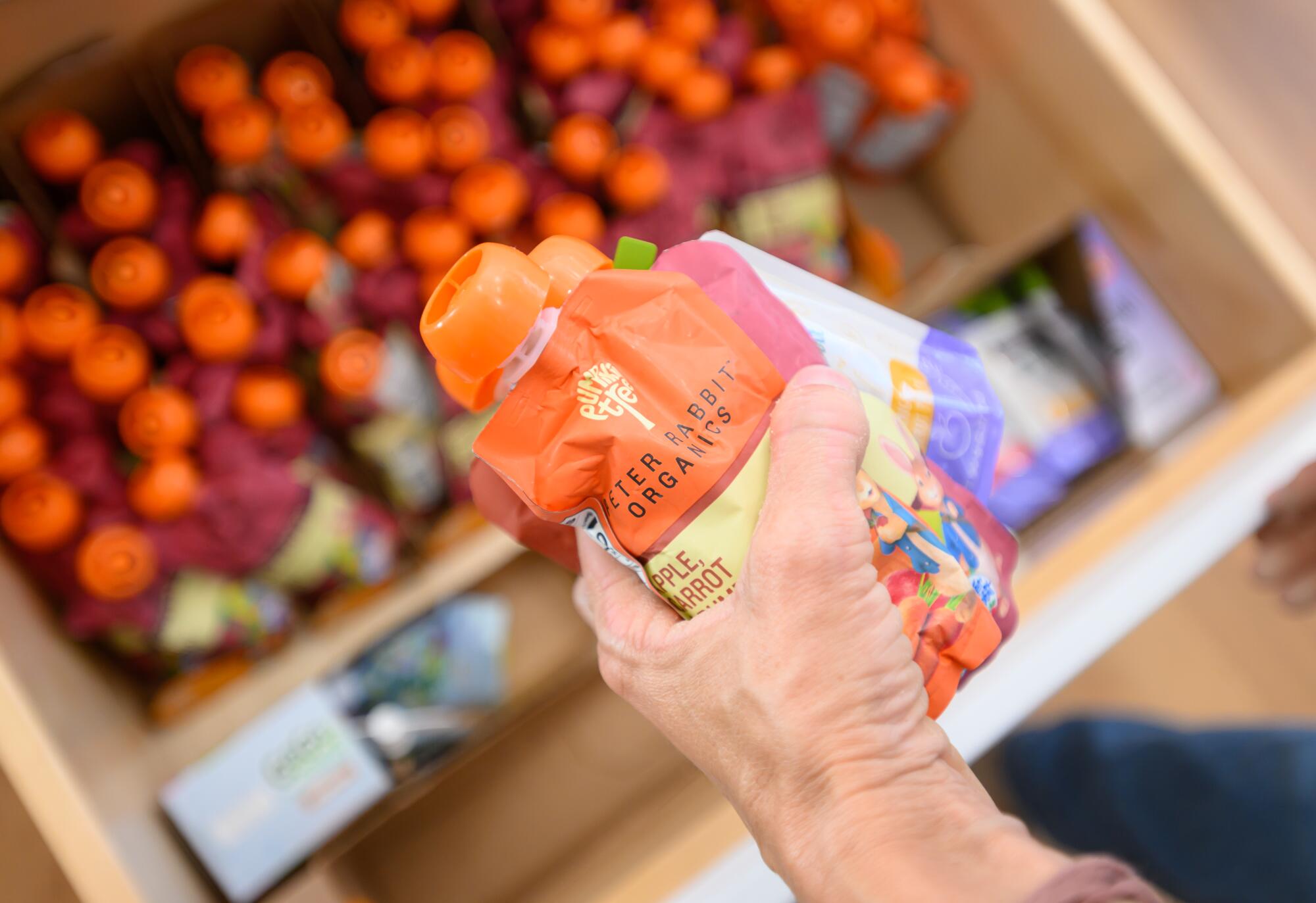
Pouches are convenient because they don’t shatter when dropped, and toddlers can suck down the slurry without help from a caregiver.
“It is so dang hard to be a parent of young children in the U.S. Having [pouches] on an airplane, having them in the car — it is so convenient that I would never take that away from parents. I used pouches with my children,” said Bridget Young, an associate professor of pediatrics at the University of Rochester School of Medicine.
“The industry has gone from jars to pouches because it’s more cost-effective and convenient,” said Dr. Tanya Altmann, a pediatrician in Calabasas and author of the book What to Feed Your Baby. But it’s what’s inside that’s important, and “not all pouches are created equal.”
As a tool, she said, pouches “can be a contributor to a family’s nutrition,” but not a prime source. Those without added sugars or salt may even have advantages over other processed snacks.
Heidi Martinez, a mother of three in Pittsburg, Calif., said she always buys the pouches with at least one vegetable. As her oldest son goes through “picky stages, I like that he is still getting some kale and beets,” she said. “I don’t know that they’re actually healthier but I feel better about it.”
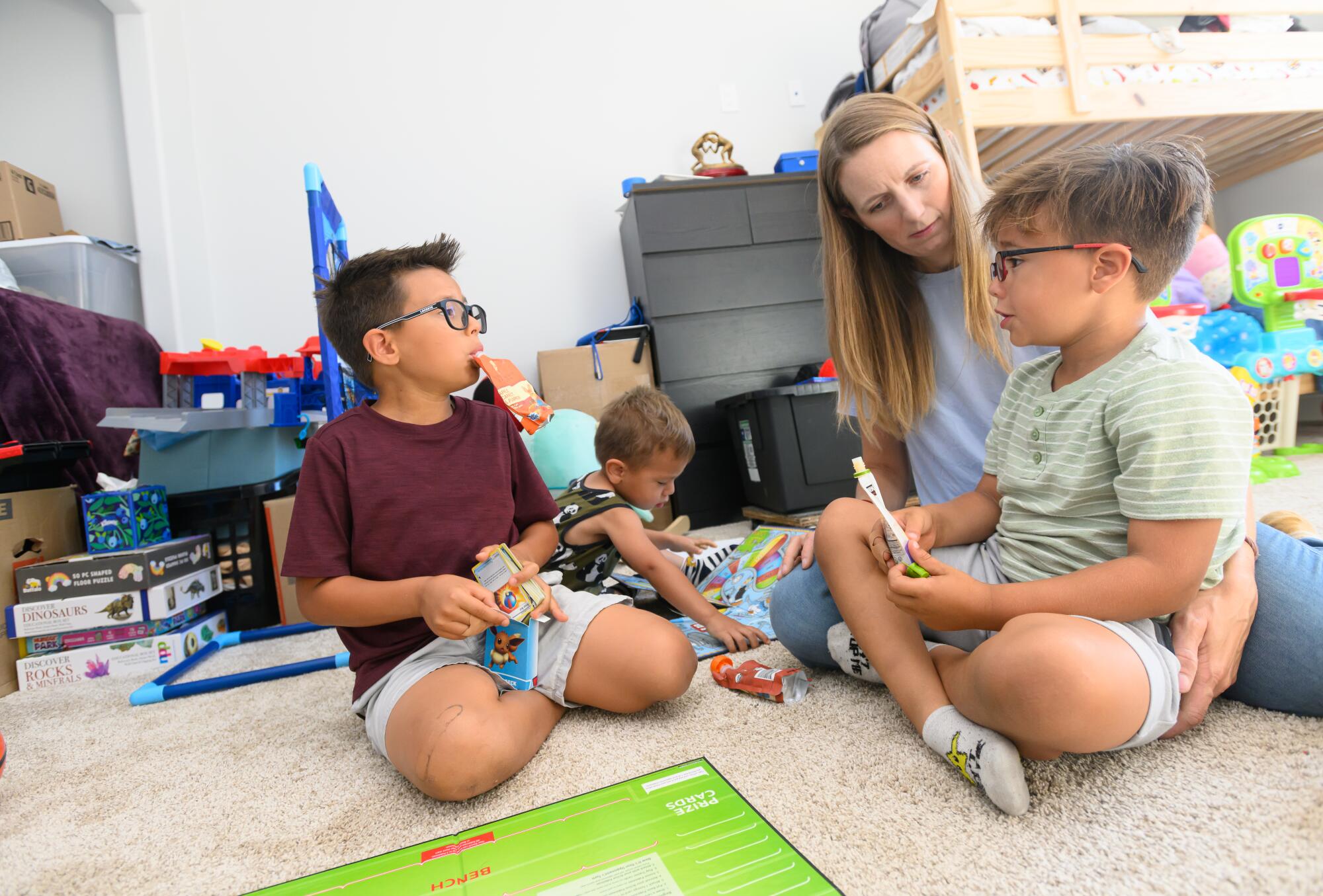
Heidi Martinez plays with her sons while they eat from pouches. “I don’t know that they’re actually healthier but I feel better about it,” she said of pouches that include vegetables.
At the age of 7, he eats two to three pouches a day.
Manufacturers appeal to parents by marketing a pouch as “all natural,” “organic” or containing vegetables.
But the advertising on the front of a pouch doesn’t necessarily reflect what’s inside. A green pouch advertised as broccoli-pear might turn out to be little more than pear puree. And a pouch labeled something like turkey dinner “might be apple sauce with a whisper of turkey,” Young said. “And there’s nothing wrong with apple sauce. But there is something wrong when you think you’re feeding your child turkey.”
Parents of picky eaters may be particularly vulnerable to this kind of marketing.
“It’s kind of the perfect storm, when the child is transitioning to solids and trying new foods,” said Fran Fleming-Milici, director of marketing initiatives at the Rudd Center for Food Policy and Health at the University of Connecticut. “You’re not sure of the nutrition that the child is getting.
Martinez said the real appeal, however, is the pouch itself. She considers pouches to be in the same category as a smoothie or yogurt, but in an easy to-go form.

Ezekiel Martinez, 7, eats from a pouch while hanging upside down at a park. He eats two to three pouches a day.
The slippery slope of sweet, smooth purees
The early years of a child’s life are crucial for developing lifelong healthy eating habits. Babies are born with a preference for sweet foods, said Jill Castle, a pediatric dietitian in Massachusetts and author of the book “Kids Thrive at Every Size.” Typically, a child must be repeatedly introduced to various foods to get them used to different textures and flavors, such as the taste of vegetables.
It’s hard to beat the convenience of pouches — they’re easy to throw in a diaper bag or hand to a screaming toddler in the car. But experts warn relying on them too much could be a problem.
Fruit puree can disguise the taste of vegetables, reinforcing sweetness, Castle said.
If a child’s diet consists mostly of pouches, “when you actually give them chopped-up carrot and peas that roll around the plate, they’re not used to that at all,” and may refuse it, said Daisy Coyle, who researches pouches at the George Institute for Global Health in Sydney, Australia.
Ideally, lumpy textures should be introduced as early as possible so the child can learn to use their tongue and jaw to manipulate and swallow food, a process that requires 30 different muscles to work together, said Susan Greenberg, a speech pathologist at Children’s Hospital Los Angeles. “We think it’s a natural process, but it’s like learning to walk,” she said.
A variety of textures is also crucial to developing a child’s long-term food preferences. “If you prolong purees and don’t introduce lumpy foods by 10 months, we have evidence that by 15 months and even 7 years, it influences food acceptance,” Greenberg said.
The full sensory experience of eating food is also important, she added — getting messy, using spoons, fingers and tiny fists to squish food and smear on a highchair and face.
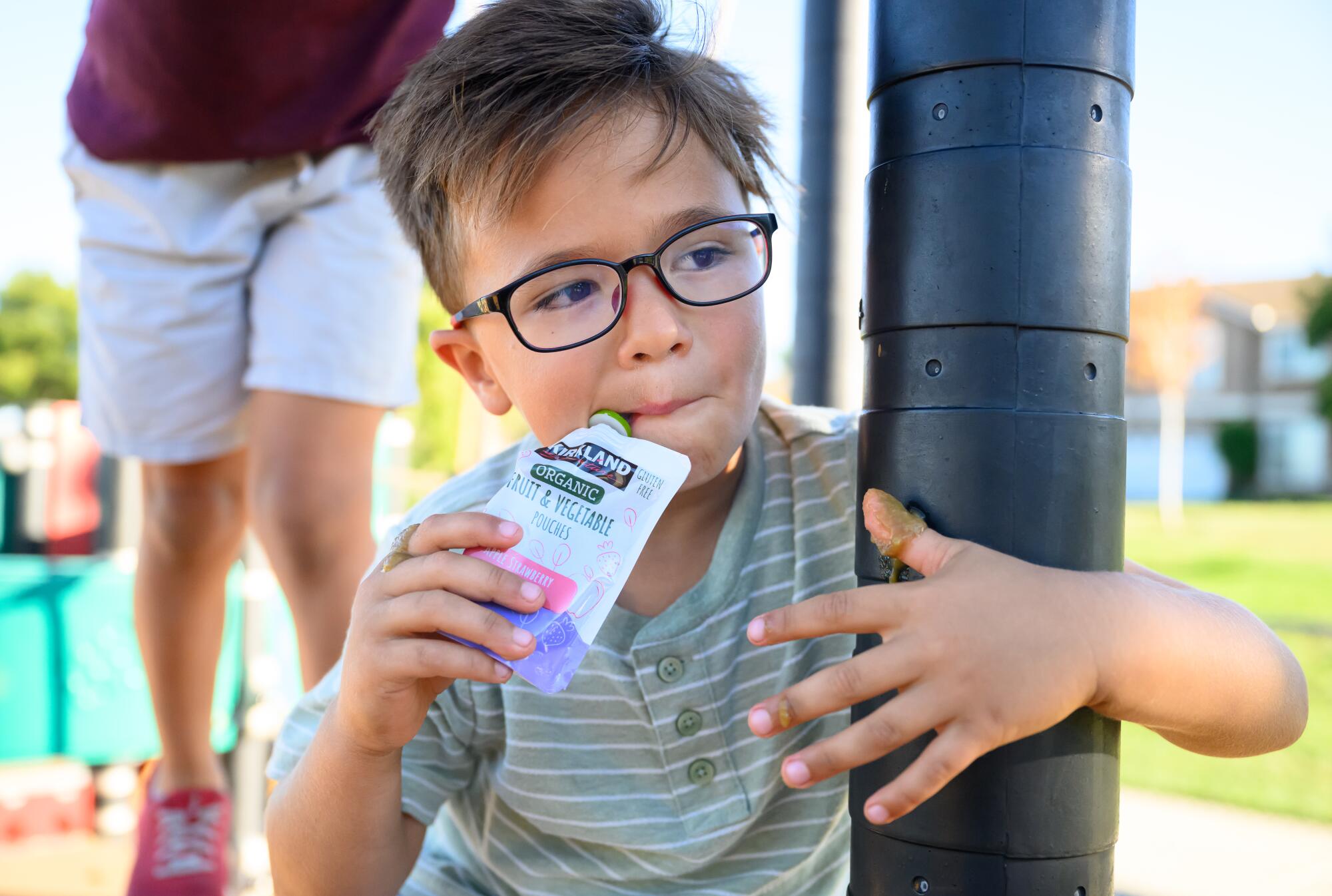
Lucas Martinez, 5, snacks while at a park.
Dentists also have concerns about what pouches mean for oral hygiene. Dr. Francisco Ramos-Gomez, director of the UCLA Center for Children’s Oral Health, said the way purees such as apple sauce stick to the teeth is different from eating an actual apple, and it sits on a child’s teeth before being washed. This prolonged exposure increases the acidity of the mouth, erodes the teeth and causes cavities.
But it’s all a matter of moderation, Greenberg said. “Pouches are easy, and we live in a world that’s really busy these days. I think we can all agree that it’s not a bad thing. It just can’t replace the other things.”
Do toddlers really need their own special food?
By about 12 months old, typically developing children do not need pureed food. “It was always a goal to get kids off of purees by 9 months and get them onto table food,” Castle said. “By 1 year, you’re sitting at the table with your family, and you’re eating what the whole family is eating.”
Toddlers and young children can eat most anything that an adult can eat, as long as it’s cut or prepared in a way that’s appropriate for their eating skills and doesn’t make it a choking hazard.
But brands have invented a whole new, lucrative category of toddler foods, from pouches and teething crackers to bars and puffs, Fleming-Milici said.
The major pouch manufacturers — including Gerber, Plum Organics and Happy Family Organics — did not respond to requests for comment from The Times.
In the last 12 months, American families have spent more than $466 million on baby food pouches, according to data from the market research firm NIQ.
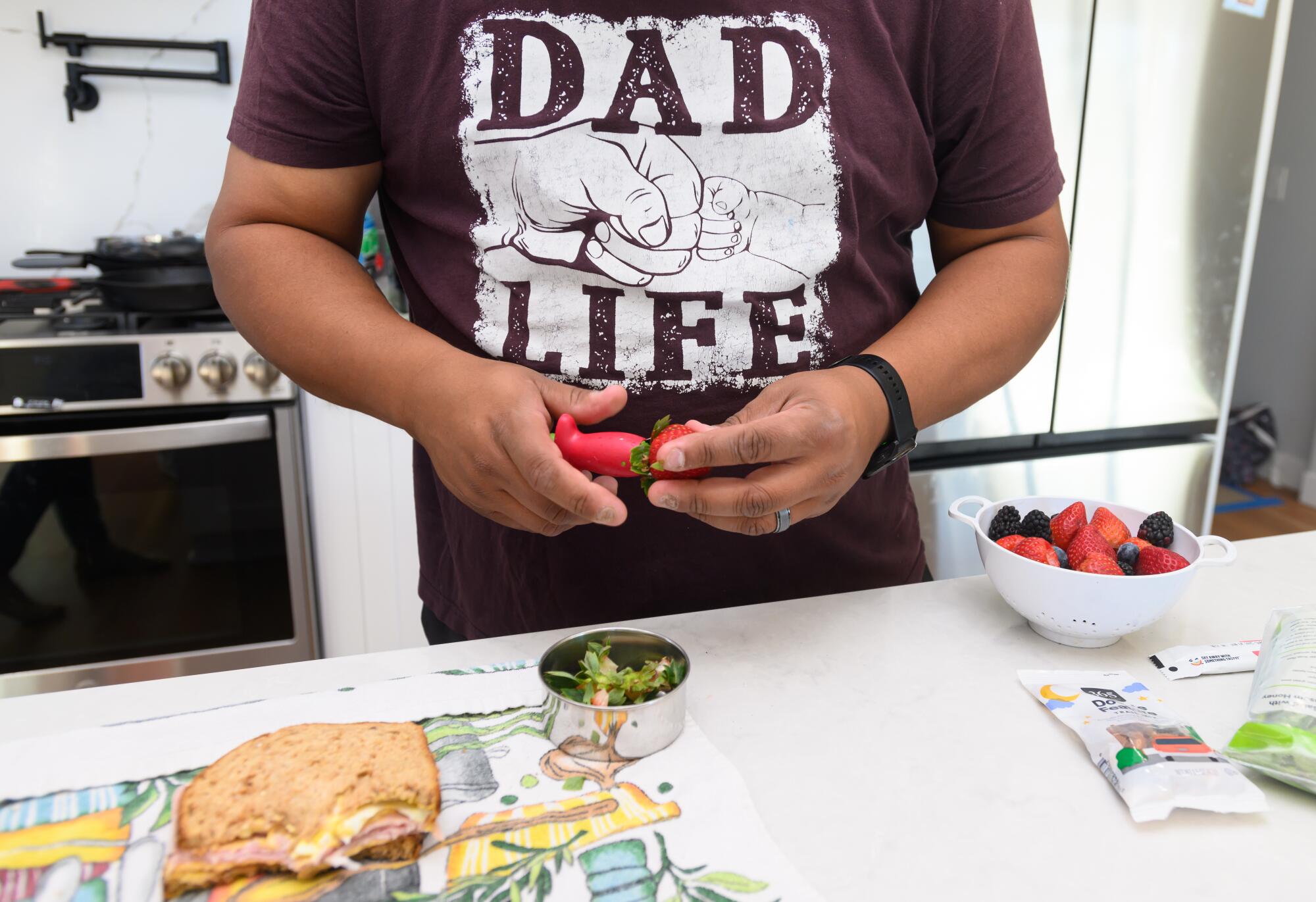
Mario Martinez prepares snacks for his three sons.
The “Wild West” of the baby food aisle
As opposed to the tightly regulated U.S. infant formula sector, baby and toddler foods do not have their own special marketing and production rules; they are subject to the same requirements as adult foods.
“The baby food market is like the Wild West,” Castle said.
The World Health Organization came up with its own nonbinding set of standards for baby food, which included limits on fat, sugar and sodium. It also requires clear labeling of ingredients and prohibits the use of health, nutrition and marketing claims on the packaging.
A study by Coyle earlier this year published in the journal Nutrients found 60% of the baby or toddler food products for sale at the top 10 grocery stores in the U.S. failed to meet the WHO nutritional recommendations. Almost all packages included at least one prohibited marketing claim, and some had as many as 11.
Earlier this year, the FDA recalled 3 million cinnamon applesauce pouches that contained extremely high levels of lead, after dozens of children across the United States were found to be suffering from lead poisoning. The FDA does not currently set heavy-metal limits or require baby food manufacturers to test for them.
“We really need to have some U.S.-based regulations, or decide we’re following the World Health Organization’s regulations. But there needs to be more tight control,” Castle said. “These are some of our youngest, most vulnerable members of our population.”
Instead of blaming families for overusing pouches, she said, new regulations, healthier ingredients that target key nutrients, and more transparent advertising are needed. “Even just having more pouches that are predominantly veggie based and less sweet would be a really positive change,” she said.

Lucas Martinez eats from a pouch. Manufacturers appeal to parents by marketing a pouch as “all natural,” “organic” or containing vegetables.
How to see through marketing pitches
To select the healthiest pouches, nutritionist Young recommends ignoring the advertising on the front of the package — including the name of the product.
Instead, flip to the back, where the ingredients are listed in order of how much is in the package, and look for pouches that list the veggies first. A pouch that lists apple first probably will be mostly applesauce.
Beth Saltz, a pediatric dietitian in Woodland Hills, said a general rule of thumb is to make sure that all of the ingredients listed could be sold in the grocery store. If the ingredients include things such as “organic tapioca starch” or “pea protein isolate,” or even natural coloring, you might reconsider.
“A little toddler does not need those,” she said.
This article is part of The Times’ early childhood education initiative, focusing on the learning and development of California children from birth to age 5. For more information about the initiative and its philanthropic funders, go to latimes.com/earlyed.

Science
Cluster of farmworkers diagnosed with rare animal-borne disease in Ventura County

A cluster of workers at Ventura County berry farms have been diagnosed with a rare disease often transmitted through sick animals’ urine, according to a public health advisory distributed to local doctors by county health officials Tuesday.
The bacterial infection, leptospirosis, has resulted in severe symptoms for some workers, including meningitis, an inflammation of the brain lining and spinal cord. Symptoms for mild cases included headaches and fevers.
The disease, which can be fatal, rarely spreads from human to human, according to the U.S. Centers for Disease Control and Prevention.
Ventura County Public Health has not given an official case count but said it had not identified any cases outside of the agriculture sector. The county’s agriculture commissioner was aware of 18 cases, the Ventura County Star reported.
The health department said it was first contacted by a local physician in October, who reported an unusual trend in symptoms among hospital patients.
After launching an investigation, the department identified leptospirosis as a probable cause of the illness and found most patients worked on caneberry farms that utilize hoop houses — greenhouse structures to shelter the crops.
As the investigation to identify any additional cases and the exact sources of exposure continues, Ventura County Public Health has asked healthcare providers to consider a leptospirosis diagnosis for sick agricultural workers, particularly berry harvesters.
Rodents are a common source and transmitter of disease, though other mammals — including livestock, cats and dogs — can transmit it as well.
The disease is spread through bodily fluids, such as urine, and is often contracted through cuts and abrasions that contact contaminated water and soil, where the bacteria can survive for months.
Humans can also contract the illness through contaminated food; however, the county health agency has found no known health risks to the general public, including through the contact or consumption of caneberries such as raspberries and blackberries.
Symptom onset typically occurs between two and 30 days after exposure, and symptoms can last for months if untreated, according to the CDC.
The illness often begins with mild symptoms, with fevers, chills, vomiting and headaches. Some cases can then enter a second, more severe phase that can result in kidney or liver failure.
Ventura County Public Health recommends agriculture and berry harvesters regularly rinse any cuts with soap and water and cover them with bandages. They also recommend wearing waterproof clothing and protection while working outdoors, including gloves and long-sleeve shirts and pants.
While there is no evidence of spread to the larger community, according to the department, residents should wash hands frequently and work to control rodents around their property if possible.
Pet owners can consult a veterinarian about leptospirosis vaccinations and should keep pets away from ponds, lakes and other natural bodies of water.
Science
Political stress: Can you stay engaged without sacrificing your mental health?

It’s been two weeks since Donald Trump won the presidential election, but Stacey Lamirand’s brain hasn’t stopped churning.
“I still think about the election all the time,” said the 60-year-old Bay Area resident, who wanted a Kamala Harris victory so badly that she flew to Pennsylvania and knocked on voters’ doors in the final days of the campaign. “I honestly don’t know what to do about that.”
Neither do the psychologists and political scientists who have been tracking the country’s slide toward toxic levels of partisanship.
Fully 69% of U.S. adults found the presidential election a significant source of stress in their lives, the American Psychological Assn. said in its latest Stress in America report.
The distress was present across the political spectrum, with 80% of Republicans, 79% of Democrats and 73% of independents surveyed saying they were stressed about the country’s future.
That’s unhealthy for the body politic — and for voters themselves. Stress can cause muscle tension, headaches, sleep problems and loss of appetite. Chronic stress can inflict more serious damage to the immune system and make people more vulnerable to heart attacks, strokes, diabetes, infertility, clinical anxiety, depression and other ailments.
In most circumstances, the sound medical advice is to disengage from the source of stress, therapists said. But when stress is coming from politics, that prescription pits the health of the individual against the health of the nation.
“I’m worried about people totally withdrawing from politics because it’s unpleasant,” said Aaron Weinschenk, a political scientist at the University of Wisconsin–Green Bay who studies political behavior and elections. “We don’t want them to do that. But we also don’t want them to feel sick.”
Modern life is full of stressors of all kinds: paying bills, pleasing difficult bosses, getting along with frenemies, caring for children or aging parents (or both).
The stress that stems from politics isn’t fundamentally different from other kinds of stress. What’s unique about it is the way it encompasses and enhances other sources of stress, said Brett Ford, a social psychologist at the University of Toronto who studies the link between emotions and political engagement.
For instance, she said, elections have the potential to make everyday stressors like money and health concerns more difficult to manage as candidates debate policies that could raise the price of gas or cut off access to certain kinds of medical care.
Layered on top of that is the fact that political disagreements have morphed into moral conflicts that are perceived as pitting good against evil.
“When someone comes into power who is not on the same page as you morally, that can hit very deeply,” Ford said.
Partisanship and polarization have raised the stakes as well. Voters who feel a strong connection to a political party become more invested in its success. That can make a loss at the ballot box feel like a personal defeat, she said.
There’s also the fact that we have limited control over the outcome of an election. A patient with heart disease can improve their prognosis by taking medicine, changing their diet, getting more exercise or quitting smoking. But a person with political stress is largely at the mercy of others.
“Politics is many forms of stress all rolled into one,” Ford said.
Weinschenk observed this firsthand the day after the election.
“I could feel it when I went into my classroom,” said the professor, whose research has found that people with political anxiety aren’t necessarily anxious in general. “I have a student who’s transgender and a couple of students who are gay. Their emotional state was so closed down.”
That’s almost to be expected in a place like Wisconsin, whose swing-state status caused residents to be bombarded with political messages. The more campaign ads a person is exposed to, the greater the risk of being diagnosed with anxiety, depression or another psychological ailment, according to a 2022 study in the journal PLOS One.
Political messages seem designed to keep voters “emotionally on edge,” said Vaile Wright, a licensed psychologist in Villa Park, Ill., and a member of the APA’s Stress in America team.
“It encourages emotion to drive our decision-making behavior, as opposed to logic,” Wright said. “When we’re really emotionally stimulated, it makes it so much more challenging to have civil conversation. For politicians, I think that’s powerful, because emotions can be very easily manipulated.”
Making voters feel anxious is a tried-and-true way to grab their attention, said Christopher Ojeda, a political scientist at UC Merced who studies mental health and politics.
“Feelings of anxiety can be mobilizing, definitely,” he said. “That’s why politicians make fear appeals — they want people to get engaged.”
On the other hand, “feelings of depression are demobilizing and take you out of the political system,” said Ojeda, author of “The Sad Citizen: How Politics is Depressing and Why it Matters.”
“What [these feelings] can tell you is, ‘Things aren’t going the way I want them to. Maybe I need to step back,’” he said.
Genessa Krasnow has been seeing a lot of that since the election.
The Seattle entrepreneur, who also campaigned for Harris, said it grates on her to see people laughing in restaurants “as if nothing had happened.” At a recent book club meeting, her fellow group members were willing to let her vent about politics for five minutes, but they weren’t interested in discussing ways they could counteract the incoming president.
“They’re in a state of disengagement,” said Krasnow, who is 56. She, meanwhile, is looking for new ways to reach young voters.
“I am exhausted. I am so sad,” she said. “But I don’t believe that disengaging is the answer.”
That’s the fundamental trade-off, Ojeda said, and there’s no one-size-fits-all solution.
“Everyone has to make a decision about how much engagement they can tolerate without undermining their psychological well-being,” he said.
Lamirand took steps to protect her mental health by cutting social media ties with people whose values aren’t aligned with hers. But she will remain politically active and expects to volunteer for phone-banking duty soon.
“Doing something is the only thing that allows me to feel better,” Lamirand said. “It allows me to feel some level of control.”
Ideally, Ford said, people would not have to choose between being politically active and preserving their mental health. She is investigating ways to help people feel hopeful, inspired and compassionate about political challenges, since these emotions can motivate action without triggering stress and anxiety.
“We want to counteract this pattern where the more involved you are, the worse you are,” Ford said.
The benefits would be felt across the political spectrum. In the APA survey, similar shares of Democrats, Republicans and independents agreed with statements like, “It causes me stress that politicians aren’t talking about the things that are most important to me,” and, “The political climate has caused strain between my family members and me.”
“Both sides are very invested in this country, and that is a good thing,” Wright said. “Antipathy and hopelessness really doesn’t serve us in the long run.”
Science
Video: SpaceX Unable to Recover Booster Stage During Sixth Test Flight

President-elect Donald Trump joined Elon Musk in Texas and watched the launch from a nearby location on Tuesday. While the Starship’s giant booster stage was unable to repeat a “chopsticks” landing, the vehicle’s upper stage successfully splashed down in the Indian Ocean.
-
Business1 week ago
Column: OpenAI just scored a huge victory in a copyright case … or did it?
-

 Health1 week ago
Health1 week agoBird flu leaves teen in critical condition after country's first reported case
-

 Business6 days ago
Business6 days agoColumn: Molly White's message for journalists going freelance — be ready for the pitfalls
-

 Science3 days ago
Science3 days agoTrump nominates Dr. Oz to head Medicare and Medicaid and help take on 'illness industrial complex'
-

 Politics5 days ago
Politics5 days agoTrump taps FCC member Brendan Carr to lead agency: 'Warrior for Free Speech'
-
/cdn.vox-cdn.com/uploads/chorus_asset/file/25739950/247386_Elon_Musk_Open_AI_CVirginia.jpg)
/cdn.vox-cdn.com/uploads/chorus_asset/file/25739950/247386_Elon_Musk_Open_AI_CVirginia.jpg) Technology5 days ago
Technology5 days agoInside Elon Musk’s messy breakup with OpenAI
-

 Lifestyle5 days ago
Lifestyle5 days agoSome in the U.S. farm industry are alarmed by Trump's embrace of RFK Jr. and tariffs
-

 World5 days ago
World5 days agoProtesters in Slovakia rally against Robert Fico’s populist government
